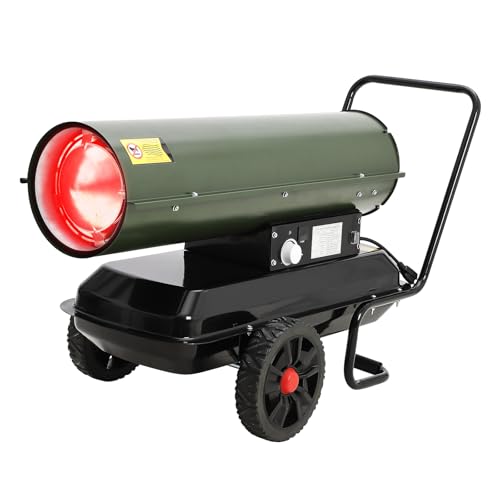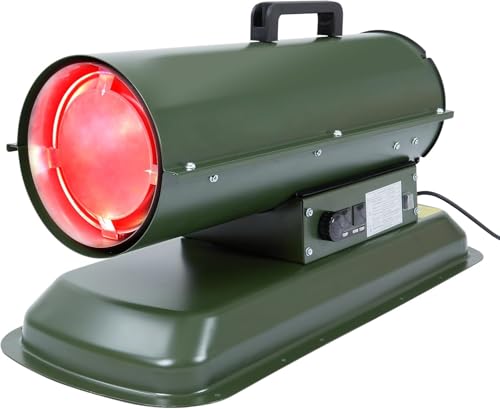Diesel torpedo heaters provide powerful, portable heat for job sites, garages, barns, and workshops. Below is a quick comparison of five relevant diesel/kerosene forced-air torpedo heaters followed by detailed product sections and an objective buying guide to help you choose the right unit for your space and fuel needs.
| Product | Approx. Output | Fuel Options | Notable Feature |
|---|---|---|---|
| VEVOR Kerosene Forced Air Heater | 215,000 BTU | Kerosene, Diesel | Thermostat With Room Temp Display |
| Towallmark 125,000 BTU Forced Air Heater | 125,000 BTU | Diesel, Kerosene, Heating Oil, Jet Fuel | 26L Tank, Up To 8 Hour Run Time |
| Mr. Heater 80,000 BTU Forced Air Heater | 80,000 BTU | Kerosene, Filtered Diesel, Fuel Oil, Jet A | Built-In Thermostat & LED Diagnostics |
| ProTemp 140,000 BTU Torpedo Heater | 140,000 BTU | Diesel, Kerosene (forced-air design) | High Airflow Up To 12,000 CFM |
| PioneerWorks 80,000 BTU Forced Air Heater | 80,000 BTU | Diesel, Kerosene, Home Heating Oil, Jet Fuel | Long Run Time—Up To 9.5 Hours |
Content Navigation
- VEVOR Kerosene Forced Air Heater, 215000BTU
- Towallmark 125,000 BTU Forced Air Diesel Heater
- Mr. Heater 80,000 BTU Forced Air Kerosene Heater
- ProTemp 140,000 BTU Kerosene/Diesel Forced Air Torpedo Heater
- PioneerWorks 80,000 BTU Forced Air Diesel Heater
- Buying Guide: How To Choose A Diesel Torpedo Heater
- 1. Heat Output (BTU) And Space Size
- 2. Fuel Compatibility And Availability
- 3. Tank Capacity And Run Time
- 4. Thermostat And Controls
- 5. Safety Features
- 6. Airflow And Distribution
- 7. Portability And Build
- 8. Maintenance And Serviceability
- 9. Indoor Use, Ventilation, And Emissions
- 10. Warranty And Manufacturer Support
VEVOR Kerosene Forced Air Heater, 215000BTU

This VEVOR unit is specified at 215,000 BTU and supports both kerosene and diesel (use one fuel at a time). The heater is designed for large indoor or semi-enclosed spaces, with a claimed capacity up to roughly 44,497 cubic feet. Key controls include a thermostat knob and room temperature display adjustable from 40°F to 110°F, helping regulate runtime and energy use.
Safety and monitoring features include overheat protection (automatic shutoff at 176°F), low-fuel auto-shutoff, a visible fuel gauge, dual fuel filters to reduce smoke and odor, and a pressure gauge for system checks. The product targets workshops, barns, and large garages where high output and thermostat control are desired.
Towallmark 125,000 BTU Forced Air Diesel Heater

The Towallmark 125,000 BTU torpedo heater provides high-output heat for spaces up to about 3,125 sq ft. It supports multiple fuel types including kerosene, diesel, home heating oil, and jet fuel (manufacturer warns against gasoline). The unit includes a sizeable 26L (about 6.87 gal) fuel tank and claims runs up to 8 hours per fill depending on load.
Call 888-896-7031 for Free Local HVAC Quotes – Compare and Save Today!
Physical dimensions and weight are provided to assess portability and storage. Intended uses include jobsites, garages, and construction areas where robust, multi-fuel compatibility and extended runtime are important considerations.
Mr. Heater 80,000 BTU Forced Air Kerosene Heater

The Mr. Heater model is a multi-fuel forced-air heater rated at 80,000 BTU suitable for spaces up to 2,000 sq ft. Supported fuels include kerosene, filtered diesel (1 and 2), fuel oil, and jet A fuel. The unit integrates a built-in thermostat and LED troubleshooting diagnostics to assist with setup and maintenance checks.
This configuration is aimed at smaller workshops and garages where user-friendly diagnostics and fuel flexibility matter. The lower BTU rating compared to larger torpedoes may be a match when high localized heat is needed without oversizing the heater for the space.
ProTemp 140,000 BTU Kerosene/Diesel Forced Air Torpedo Heater

ProTemp’s torpedo heater emphasizes airflow and efficiency, with matched direct-drive motors and blades rated up to 12,000 CFM. The heater is designed for warehouses, construction sites, and workshops where strong air movement distributes heat quickly. The powder-coated steel guards add corrosion resistance for heavy-duty environments.
Call 888-896-7031 for Free Local HVAC Quotes – Compare and Save Today!
Energy-conscious design is referenced, with lower amperage draw (as little as 1.6 amps) noted for the fan motor. The unit suits users prioritizing air circulation and durable construction along with mid-to-high BTU output for larger interior spaces.
PioneerWorks 80,000 BTU Forced Air Diesel Heater

PioneerWorks offers an 80,000 BTU forced-air heater with a 4.76 gallon fuel tank and claimed run times up to 9.5 hours per fill. The model supports multiple fuels including diesel, kerosene, home heating oil, and jet fuel (not gasoline) and is positioned for jobsite, garage, and outdoor workspace heating.
Weight and dimensions make it relatively portable compared with larger torpedo heaters. The long run time and multi-fuel capability aim to reduce refueling frequency during extended work shifts or overnight heating requirements.
Buying Guide: How To Choose A Diesel Torpedo Heater
1. Heat Output (BTU) And Space Size
Match heater BTU output to the cubic volume and insulation level of the space. Higher BTU units (100k–400k) are best for large, poorly insulated workshops or warehouses. Smaller shops and garages often need 50k–100k BTU. Consider heat losses from open doors or ventilation when sizing.
2. Fuel Compatibility And Availability
Confirm the heater’s supported fuels: diesel, K-1 kerosene, home heating oil, or jet fuel. Avoid gasoline unless explicitly allowed. Choose a fuel type that is convenient and safe to store on site and verify any fuel-specific recommendations (e.g., K-1 kerosene for reduced odor).
3. Tank Capacity And Run Time
Tank size determines uninterrupted run time. Larger tanks (6+ gallons) reduce refueling frequency. Compare consumption rates (liters/gallons per hour) or stated run times to plan for shift lengths and downtime for refills.
4. Thermostat And Controls
Thermostat control and temperature displays permit automated cycling and improved energy efficiency. Units with thermostats help maintain set temperatures and can reduce fuel use compared with manual-only models.
5. Safety Features
Look for overheat protection, low-fuel shutoff, flame/fuel filters, and clear diagnostic indicators. Proper safety features mitigate fire and carbon-monoxide risk; however, forced-air diesel heaters often require adequate ventilation, so always follow manufacturer ventilation guidance.
6. Airflow And Distribution
High CFM ratings and fan design improve heat distribution across larger spaces. If you need rapid warm-up or even temperature across the workspace, prioritize units with higher airflow specifications and direct-drive fan designs.
7. Portability And Build
Consider weight, handles, wheel kits, and footprint. Permanently attached tanks and wheel kits increase mobility for heavy units, while smaller heaters are easier to move by hand. Rugged steel guards and powder-coated finishes improve durability in jobsite conditions.
8. Maintenance And Serviceability
Check for easily accessible filters, replaceable nozzles, and clear troubleshooting diagnostics. Regular maintenance items include fuel filter replacement, nozzle cleaning, and fan/motor checks. Availability of replacement parts and local service can reduce long-term costs.
9. Indoor Use, Ventilation, And Emissions
Forced-air diesel/kerosene torpedo heaters introduce combustion products and may produce fumes. Verify whether the model is intended for indoor or outdoor use; provide adequate ventilation and, if required, carbon-monoxide monitoring. Follow manufacturer guidelines for safe distances and exhaust management.
10. Warranty And Manufacturer Support
Review warranty terms and available customer support. Professional jobsite environments benefit from clear warranty coverage and accessible technical documentation for troubleshooting and parts replacement.
Tips for Getting the Best HVAC Prices
- Prioritize Quality Over Cost
The most critical factor in any HVAC project is the quality of the installation. Don’t compromise on contractor expertise just to save money. - Check for Rebates
Always research current rebates and incentives — they can significantly reduce your overall cost. - Compare Multiple Quotes
Request at least three estimates before making your choice. You can click here to get three free quotes from local professionals. These quotes include available rebates and tax credits and automatically exclude unqualified contractors. - Negotiate Smartly
Once you've chosen a contractor, use the proven strategies from our guide — How Homeowners Can Negotiate with HVAC Dealers — to get the best possible final price.
